Allen Tiller's Blog, page 25
August 25, 2019
Red Triangle Day - WWI
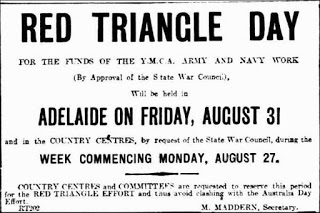 Red Triangle Day
Red Triangle Day In an effort to raise money for Australian soldiers overseas during World War One, the Y.M.C.A (Young Men’s Christian Association) began the Red Triangle campaign in 1917.
In an effort to raise money for Australian soldiers overseas during World War One, the Y.M.C.A (Young Men’s Christian Association) began the Red Triangle campaign in 1917.The campaign spanned all of Australia and rolled out through South Australia over many months.
In Adelaide, the Adelaide Citizens Committee became involved in the fund-raising effort and through the dedication of 700 female volunteers, raised over two and half thousand pounds in one day on May 24th, 1917.
This was achieved by closing off sections of Rundle Street and Gawler Place and holding a market. A procession of troops, bands and decorated cars also added to the atmosphere of the day.
 As the State began to embrace the Red Triangle Day appeal, it was decided that its official “day” would be August 31st across the State.
As the State began to embrace the Red Triangle Day appeal, it was decided that its official “day” would be August 31st across the State.A gala day was held in Mount Barker in August 1917, which became an all-night fund-raising event held at The Mount Barker Town Hall.
Kapunda celebrated Red Triangle Day on September 1st, 1917. The Kapunda celebration featured a button unique to their celebration, which is extremely rare and collectable today.
Peterborough (then known as Petersburg) celebrated in September 1917, proudly supported by the Burra Ladies Band. This was the first time a “Lady’s Band” had ever played a concert in Peterborough. This led to large crowds gathering in the Town Hall later in the day to hear the ladies sing, while local ladies sold pins and flowers to raise money for the Y.M.C.A.
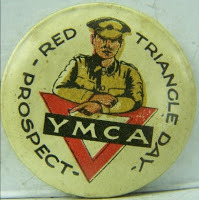 Stansbury, on the Yorke Peninsula, celebrated Red Triangle day with a fete on August 31st, 1917.
Stansbury, on the Yorke Peninsula, celebrated Red Triangle day with a fete on August 31st, 1917.Through the cooperation of the State War Council, The Minister of Education and the Children’s Patriotic Fund a fund-raising competition in South Australian schools raised money for the Y.M.C.A. Red Triangle Day appeal. The reward for the winning school was a large banner proclaiming their effort and the honour of knowing they were supporting the Australian war effort overseas.
The Red Triangle appeal carried over into 1918, with Unley, in June 1918, being canvassed with a door to door sale of a unique Red Triangle pin created for the day. A small gathering of locals also attended a small musical show at the Unley City Hall headquarters.
In May 1919, Red Triangle Day continued in Port Pirie with a football match between the Smelter Imperials and the Y.M.C.A.
The August 1917 appeal in Australia raised £159,037 28 (that’s around $14,198,000 in today’s money).
Researched and written by Allen Tiller © 2018
References
1917 'RED TRIANGLE DAY', The Mount Barker Courier and Onkaparinga and Gumeracha Advertiser (SA: 1880 - 1954), 3 August, p. 2. , viewed 30 Dec 2018, http://nla.gov.au/nla.news-article147702293
Advertiser (Adelaide, SA: 1889 - 1931), Saturday 21 July 1917, page 8
1917 'Y.M.C.A. WAR WORK', Daily Herald (Adelaide, SA: 1910 - 1924), 1 August, p. 8. , viewed 30 Dec 2018, http://nla.gov.au/nla.news-article124859553
1917 'RED TRIANGLE DAY', Daily Herald (Adelaide, SA: 1910 - 1924), 2 August, p. 3. , viewed 30 Dec 2018, http://nla.gov.au/nla.news-article124859820
1917 'THE COUNTRY.', The Register (Adelaide, SA: 1901 - 1929), 4 August, p. 5. , viewed 30 Dec 2018, http://nla.gov.au/nla.news-article60466404
1917 'RED TRIANGLE DAY APPEAL', Chronicle (Adelaide, SA: 1895 - 1954), 4 August, p. 34. , viewed 30 Dec 2018, http://nla.gov.au/nla.news-article87607153
1917 'Advertising', The Mail (Adelaide, SA: 1912 - 1954), 4 August, p. 3. , viewed 30 Dec 2018, http://nla.gov.au/nla.news-article64042545
1918 'ONLEY RED TRIANGLE DAY.', Daily Herald (Adelaide, SA: 1910 - 1924), 8 June, p. 4. , viewed 30 Dec 2018, http://nla.gov.au/nla.news-article124...
1919 'RED TRIANGLE DAY.', Recorder (Port Pirie, SA: 1919 - 1954), 28 May, p. 2. , viewed 30 Dec 2018, http://nla.gov.au/nla.news-article95415489
1917 'RED TRIANGLE DAY.', Petersburg Times (SA: 1887 - 1919), 5 October, p. 3. , viewed 30 Dec 2018, http://nla.gov.au/nla.news-article109...
Published on August 25, 2019 13:41
August 19, 2019
The Strange Case of the Headless Calf.
The Strange Case of the Headless Calf.
In 1875, Mount Gambier resident Mrs Buchan, over three nights, had strange dreams about her daughter Mary, who had mysteriously disappeared.
 Mary Buchan
Mary BuchanPhoto: Les Hill Collection - Mount Gambier Library.Mary Buchan had fallen in love with an older man named William Page. They dated for a while, and it was thought it would not be long until he proposed. Then one day, Mary disappeared. Police investigated, but could not find the girl, nor any motive for her leave the town unannounced.
The night after her disappearance, Mary’s mother had a disturbing nightmare. In her dream, she was looking over Hedley Park at Mount Gambier. (Hedley Park was bounded by Sturt Street in the north, Bay Road in the east, and South Terrace in the south, with Cemetery Road to its west.)
In the dream, Mrs Buchan could see a herd of cows standing in one corner of the field. She watched as a calf left the herd and walked across the field. It stopped at about halfway across the field. Mrs Buchan watched the calf, and suddenly it dawned on her, that the calf that had just stopped, but had walked across the field, had no head!
Mrs Buchan woke up sweating and full of terror.
She told a close friend of the dream, and it was passed off as a nightmare due to the stress of her
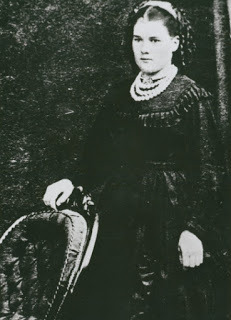 Mary Buchan 1870: SLSA: [16747]missing daughter. The following night, Mrs Buchan had the exact same dream. Again, it was brushed off as a nightmare caused by stress.
Mary Buchan 1870: SLSA: [16747]missing daughter. The following night, Mrs Buchan had the exact same dream. Again, it was brushed off as a nightmare caused by stress.After the third night of having the exact same dream, Mrs Buchan could ignore it no longer. The following morning, she reported it to the police who ignored her claim. Mrs Buchan instead arranged with friends to plough the field. They found in the exact spot Mrs Buchan had seen the headless calf, the remains of her daughter, Mary. The police were called to confirm and investigate.The spot where Mary Buchan’s lifeless body lay was only 150 metres from a police station and even less from houses. If she had screamed, people most certainly would have heard her. The field had only recently been ploughed, so her shallow grave was not noticeable to the naked eye.
It was eventually revealed that William Page had murdered Mary Buchan by strangulation after she refused his sexual advances. Page was later hung at the Mount Gambier Gaol, which you can read about, and more details about the case, at a previous blog post here:
http://hauntedadelaide.blogspot.com/2013/03/ghosts-of-south-coast-mount-gambier.html
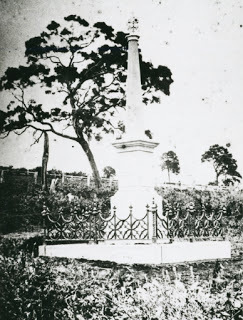 Mary Buchan's grave 1875 SLSA: [16748]Mary Julia Buchan is buried in Lake Terrace Cemetery, Mount Gambier, section G, plot 203. She was just 19 years old at the time of her murder. May she rest in peace. (her mother Mary Buchan is buried nearby in plot 236.)
Mary Buchan's grave 1875 SLSA: [16748]Mary Julia Buchan is buried in Lake Terrace Cemetery, Mount Gambier, section G, plot 203. She was just 19 years old at the time of her murder. May she rest in peace. (her mother Mary Buchan is buried nearby in plot 236.)Researched and written by Allen Tiller © 2019
Bibliography
'DREAMS OF DEATH', The Mail, (9 November 1929), p. 3. 'THE HEDLEY PARK TRAGEDY.', Border Watch, (7 August 1875), p. 2.
Published on August 19, 2019 18:23
August 12, 2019
Infanticide at North Adelaide
Infanticide at North Adelaide
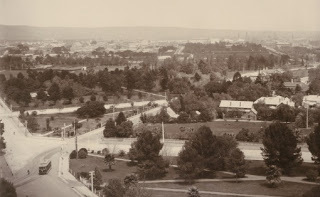 North Adelaide 1910- SLSA: [B 3466]
North Adelaide 1910- SLSA: [B 3466]History is not always kind, nor nice...
The Town Clerks Avenue isn’t well-known terminology for many Adelaidean’s, even many that probably walk the avenue daily. It’s a walkway through the parklands leading from Sir Edwin Smith Avenue at Angas Gardens, along the Torrens River to Frome Road. It was established in 1917.
On December 20, 1885, Adelaide Corporation Ganger (labourer) John Collins was walking along the Town Clerks Avenue just after 7am, heading into work from his home in North Adelaide. As he was wandering along the path, he noticed a package lying in a drain. He retrieved the package and look inside to find the corpse of a baby boy, wrapped in newspaper and a large sheet of brown paper.
The blood on the paper was fresh and still damp.
Collins rushed to the North Adelaide police station and reported the find to the local constable Bea. Police-constable Bea attended the location and found three men standing around the package discussing its contents. Bea retrieved the package and returned with it to the police station.
That evening Doctor Melville Jay attended the police station and conducted a post-mortem examination on the child’s body. He found that the child weighed just over six pounds, was 12 inches long, and from the appearance of the babies’ head, had been through a long labour. The child’s head had been almost severed from its body. There were large incisions across the neck that cut through to the spine.
Most horrific, Doctor Jay discovered the organs of the baby and discovered that it had been born alive, the right lung was full of air, but he concluded that its life must have been cut short very quickly as the left lung had failed to be inflated.
Also submitted to the post-mortem were a knife and men’s jacket that had been discovered in a yard on Poole Street in North Adelaide.
During an inquest held at the Destitute Asylum on Kermode Street, witnesses came forward with descriptions of the mother of the child. The first was Ada Chickwidden. On 19 December, prior to the finding of the babies’ body on the Town Clerks Avenue. Ada Chickwidden saw, at 4 o’clock in the afternoon, a young woman of around 2 to 30 years of age, enter Hosking’s Shop in North Adelaide. The woman seemed unwell.
She noted that she wore a black dress with a square plaid in front. The woman had entered the shop to inquire about the time.
Prior to her entering the shop, Chickwidden had noticed the woman looking over the fence into the backyard. The woman left, and Chickwidden went back to her duties, leaving a bag with some paper in it, and a coat at the rear door outside the shop to be disposed of.
On December 20, Chickwidden saw blood on the bricks at the rear of the shop, near the bag and coat she was taken outside the day prior.
The night before, when laying in bed, she had heard someone telling a dog to quiet down but hadn’t paid much attention.
During the inquest, Chickwidden identified the papers the child had been wrapped in as being the same ones she had put outside in a bag, she had meant to dispose of at a later date.
Chickwidden also stated she had seen the woman lying in the sand on New Years Day at Largs Bay, she went to speak to her, but the women would not look at her, so she left her there.
The next witness in the inquest was Catherine Hollak of Finnis Street. Hollak stated she had heard noises coming from an empty “china man’s hut” next door to her own house. She went to inspect what was going on and found a young woman there. Hollak identified the young woman as one her and her husband had allowed to stay in their house a month prior. Hollak said to her; “This is a rather peculiar place for you to come.”; but the woman didn’t reply.
Hollak asked her if she had a home, the woman replied; “No, I wish my throat was cut or that I was in the Torrens.”
Hollak then offered the woman to come to stay at her house again and told the woman she would be back shortly, as she was first going to ask her husband if it was ok. Hollak left and when she returned the woman was gone.
Hollak looked for, and chased her down in a street nearby, she asked the woman why she had left, but received an indistinct reply. The woman walked off and left Hollak standing there confused.
Hollak described the woman as wearing a black dress and a black hat with a feather in it. She had seen the woman about the place for many years but had never known her name. Hollak knew the woman worked as a servant somewhere near Park Street but knew no more about her.
A few days later the inquest reached its conclusion of: “wilful murder against some person or persons unknown.” It is not known whether the baby received a proper burial, or if the woman ever came forward
Researched and written by Allen Tiller © 2019
Bibliography
'INFANTICIDE AT NORTH ADELAIDE.', South Australian Register, (15 January 1885), p. 7.'THE NORTH ADELAIDE INFANTICIDE.', Evening Journal, (6 January 1885), p. 2.
Published on August 12, 2019 16:01
August 9, 2019
Shades of Black – Allen Tiller
Shades of Black – Allen Tiller
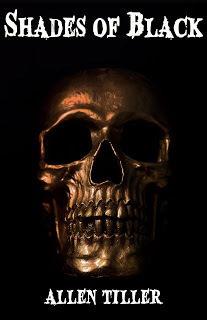
All my life I’ve written poetry and short stories. For a few years I was an editor on what was the worlds biggest poetry website (2002- 2006) Author-Me. I was never confident about letting others read my inner voice, but I eventually overcame that. Putting some of that work into a collection was a daunting, but after an interview with the Rev Shawn Whittington, I thought “what the hell, why not do it? “…
So Ladies and Gentleman, without further Adieu, I present: “Shades of Black”, a collection of poetry, prose and short stories by me
Published on August 09, 2019 18:30
August 6, 2019
The Green Dragon Brewery
The Green Dragon Brewery
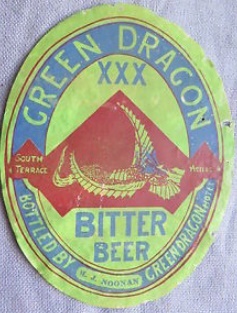
Chambers and Blades Brewery Ltd was founded in 1871 by F.J. Blades with his Brothers-in-law, William and Charles Chambers.Chambers and Blades bought the Green Dragon Hotel, The Tanner’s Arms in Unley and the Queens Head Hotel and South Australian Hotel (of which they paid 28, 500 pounds for the freehold lease) in Adelaide. The men also owned vacant land on Surflen Street, Adelaide.The Green Dragon Brewery located behind the hotel was first occupied by Chambers and Blade Brewers Ltd. who used the building until 1901.
Green Dragon Brewery was merged with the Walkerville Co-operative Brewing Company in 1901. William Chambers remained on the board of the new company as did Frederick Blades.
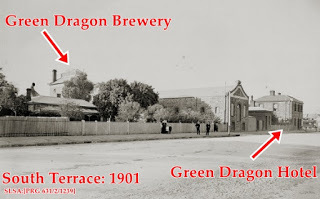
For the following six years the former Green Dragon Brewery building remained empty until, in 1907, it was taken over by Richard Mitchell & Co. Carriers. In 1916, the Adelaide Motor Bus Company used the building for storage of its double-decker buses for a year. From 1917, Richard Mitchell & Co. again used the large building for storage.
In 1926 a fire broke out in the old building gutting much of the building.
In 1931 the building was offered for sale.
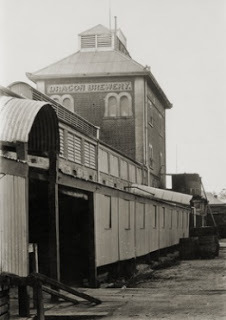 Green Dragon Brewery 1901
Green Dragon Brewery 1901SLSA: [PRG 631/2/1241]
In 1952, the Green Dragon Brewery building still stood as a local landmark. It was noted in The News, that the buildings name had influenced local nomenclature with a Green Dragon Furniture Storage House operating nearby, and a new Green Dragon Service Station, operated by ex-servicemen about to open.
Mr Frederick James Blades (1829 - 1895) came to South Australia in 1849 from Stamford, Lincolnshire, England. Blades married Mary Chambers (1846 –1925) in 1869.Blades died at his estate, “Lyndhurst” on South Terrace on 16 November 1895, aged 65. He left a wife and seven children. F.J. Blades is buried in West Terrace Cemetery, Adelaide.
Charles Chambers (1843-1877) and William Chambers (1849-1930) were sons of John Chambers, a wealthy pastoralist and mining speculator who had stations at Cherry Gardens, Cobdogla, and near present-day Renmark and mining interests near Blinman.
Charles was married for only four years to Mary Ransford (1849-1925) before his death in 1877. The pair had one child, Edgar, who managed the West End Brewery in Broken Hill. Charles died at his sheep station at Brimbago (near Keith). William Chambers was born at Cherry Gardens. He was educated at Young’s School, and later at St Peters College before working on one of his father's many cattle stations. He married Clara Bailey (1854-1937) in 1877. Together they had three children. William retired in 1912 due to his failing health. William died at his home on Fitzroy Terrace, Thorngate in 1930, aged 80. William and Clara Chambers are buried in the North Road Cemetery, Nailsworth.
Researched and written by Allen Tiller © 2019
Sources:'Advertising', South Australian Register, (27 August 1877), p. 2'Advertising', The Advertiser, (5 July 1937), p. 12.Ancestry.com. Australia, Death Index, 1787-1985 [database on-line]. Provo, UT, USA: Ancestry.com Operations, Inc., 2010.'ASSIGNMENT.', Evening Journal, (25 September 1872), p. 2.'BIG CITY PROPERTY TO BE AUCTIONED', Advertiser and Register, 20 June 1931, p. 10. 'Death Of Mr W. Chambers, Pioneer Brewer', The Register News-Pictorial, (24 May 1930), p. 22.Donovan, Marsden & Stark, City of Adelaide Heritage Survey 1982, Adelaide City Archives. 'Family Notices', Evening Journal, (20 November 1895), p. 2.'FIRE IN ADELAIDE.', Recorder, (22 November 1926), p. 4.'OBITUARY', The Advertiser, (24 May 1930), p. 17.Roberts, Mick, Early taverns of South Australia, Time Gents, (21 August 2017), https://timegents.com/2017/08/21/earl... LATE MR. F. J. BLADES.', The Express and Telegraph, (18 November 1895), p. 3.'The odd spot', News, (15 August 1952), p. 3.
Published on August 06, 2019 02:30
July 29, 2019
Closed Hotels in South Australia: Green Dragon Hotel
Closed Hotels in South Australia: Green Dragon Hotel
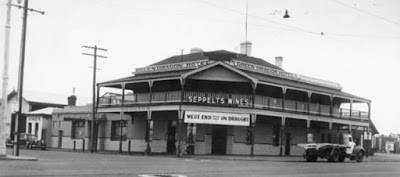 Green Dragon Hotel circa 1940 - SLSA: B 9458The Green Dragon Hotel opened in 1858 on the corner of South Terrace and Pulteney Streets. It was built for Mr John Mitten and contained eight rooms, stockyard and stables. Mitten, originally from Hereford England, passed away in the hotel in 1859 after a short illness. The hotel was left to his niece Mary Cant.
Green Dragon Hotel circa 1940 - SLSA: B 9458The Green Dragon Hotel opened in 1858 on the corner of South Terrace and Pulteney Streets. It was built for Mr John Mitten and contained eight rooms, stockyard and stables. Mitten, originally from Hereford England, passed away in the hotel in 1859 after a short illness. The hotel was left to his niece Mary Cant.The hotel has many additions made over the years. The most substantial being extensions in 1891 and 1898. A balcony was added in 1924.
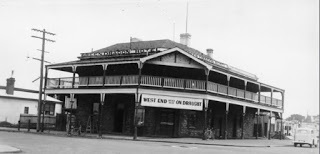 Green Dragon Hotel 1939 - SLSA: B 8595 In 1939, new owner, Mr Lewis undertook restorations and improvements of the old hotel. Lewis installed a large lounge, a new kitchen and servery, and new laundry and toilet facilities. Lewis also installed new sand-blasted dragon-motif glasswork throughout the hotel. A new bar was installed that ran the entire length of Hanson Street; this was achieved by removing the former kitchen.
Green Dragon Hotel 1939 - SLSA: B 8595 In 1939, new owner, Mr Lewis undertook restorations and improvements of the old hotel. Lewis installed a large lounge, a new kitchen and servery, and new laundry and toilet facilities. Lewis also installed new sand-blasted dragon-motif glasswork throughout the hotel. A new bar was installed that ran the entire length of Hanson Street; this was achieved by removing the former kitchen. In 1912, an argument broke out in court between the Green Dragon Hotel publican, David Sharp’s lawyer, Mr Smith and police Constables Fellows and England.
It was revealed in court that on Sunday December 17 1912, the two police constables dressed in civilians clothes, had gone to a few hotels in Adelaide, and knocked on the door asking for drinks. Sharp’s had been the only hotel they had visited that allowed them in. It was illegal in Adelaide at the time to sell alcohol on a Sunday.
In court, Mr Smith called the police out for entrapment, arguing they lied and misrepresented themselves. Police Inspector Birchall, who was present at the proceedings objected that the two men were carrying out their duties. The argument continued for some time, with Mr Smith insinuating that the police were setting up Mr Sharp and other publicans due to racism and entrapment.
Whatever Mr Smith was trying to achieve by outrightly accusing and abusing the police in an open court, backfired. Mr Sharp was eventually fined 5 pounds and sentenced to a month in Adelaide Gaol.
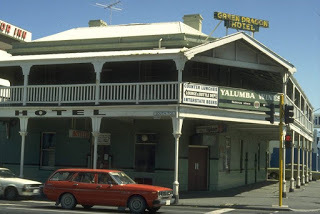 Green Dragon Hotel circa the late 1970sIn 1942, a fight broke out in the hotel, which ended in court. A labourer from Frewville, Joseph McDade assaulted publican, Michael Noonan. McDade was fined a total of £8 12s 6d (approx. $630 today) for the assault and for wilful damage of a glass door.
Green Dragon Hotel circa the late 1970sIn 1942, a fight broke out in the hotel, which ended in court. A labourer from Frewville, Joseph McDade assaulted publican, Michael Noonan. McDade was fined a total of £8 12s 6d (approx. $630 today) for the assault and for wilful damage of a glass door.The Green Dragon Hotel was one of many hotels in Adelaide the murderous paedophile group, 'The Family', would frequent to find young men for sex, and to also carry out their brutal and heinous attacks.
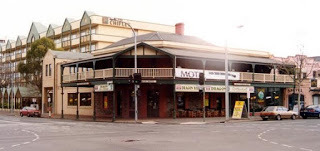 Frostbites - 1999 The hotel was often frequented by celebrities, including State Premier Donald Dunstan with many coming to see acclaimed singer, Sybil Graham. The hotel ceased operating as The Green Dragon in 1998, reopening as Frostbites. Frostbites lasted until 2001.
Frostbites - 1999 The hotel was often frequented by celebrities, including State Premier Donald Dunstan with many coming to see acclaimed singer, Sybil Graham. The hotel ceased operating as The Green Dragon in 1998, reopening as Frostbites. Frostbites lasted until 2001.The building is currently a Fasta Pasta.
Researched and written by Allen Tiller ©2019
Sources:
'Additions to Historic Hotel', The Mail, (11 November 1939), p. 16.
Adelaidepedia, Green Dragon Hotel, National Trust of South Australia and Adelaide City Council, (2019), https://adelaidepedia.com.au/wiki/Green_Dragon_Hotel
Decimal Inflation Calculator, Reserve Bank of Australia, https://www.rba.gov.au/calculator/annualPreDecimal.html'FINES FOR CLASH AT HOTEL', News, (5 February 1942), p. 3.
Hoad, J.L., Hotels and publicans in South Australia 1836-1984, (Adelaide, 1986), p. 264.
Hunt, Nigel, Shadowy clique preyed on the young,Sunday Mail, (1 April 2008), https://www.adelaidenow.com.au/news/south-australia/shadowy-clique-preyed-on-the-young/story-e6frea83-1111115956032.
Lustri, Susan, 'Yelland, Keith Mills’, Architecture Museum, University of South Australia, 2013, Architects of South Australia: [http://www.architectsdatabase.unisa.e...].
'OLD BUILDING', News, (15 June 1931), p. 7.
'POLICEMAN AMD PUBLICAN', The Express and Telegraph, (5 January 1912), p. 2.
Published on July 29, 2019 22:51
July 22, 2019
Suicide by Gelignite – Wallaroo 1906
Suicide by Gelignite – Wallaroo
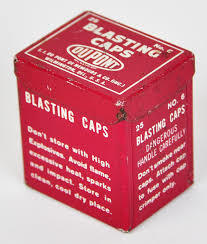
In 1906 an inquest was held by James Malcolm into the suicide of William Frederick White, a quarryman in the local flux quarry. Mr White, aged 52, was widowed with five children. His wife, Elizabeth, had died on August 1905.
It was said his children feared him as he was often drunk and abusive since the death of his wife. Often, he threatened to kill himself.His children often refused to sleep at the house. The previous evening to the suicide, White had found himself home alone which made him morose. On the Saturday morning of the incident, White’s eldest son, 16-year-old William Jnr. returned home to fetch a box for his sister who had spent the previous night in Moonta. William Jnr spoke to his father, who was sober. White Snr. asked where the children were, which William told him that had stayed at friends’ houses. William didn’t think anything suspicious in his father’s behaviour, took the box for his sisters and left.
William wasn’t fifty meters down the road when he heard an explosion. He ran back to the house and found his father on a sofa at the back of the house, his hand and his head had been blown off. Police removed the body, and during their investigation found sticks of gelignite, fuses and caps in the house.Evidence during the inquest was given by W.F. White Junior and W.A. Webber, son in law of William White Snr.
The jury, at the end of the inquest declared that: “ William Frederick White came to his death by an act of his own hands while in a melancholy state of mind.” Members of the jury then donated the fees paid for jury duty to the children of the deceased who were now orphaned.
Suicide by gelignite was not confined to Wallaroo, South Australia. Cases of this horrific way to die can also be found on Trove in Broken Hill NSW(1917), Castle Hill NSW(1954), Cairns QLD (1929), Melbourne Vic (1926), Perth WA (1906), Claremont WA (1930) and even across the pond in New Zealand (1922), just to name a few.
Researched and written by Allen Tiller © 2019.
Sources:
'SUICIDE BY GELIGNITE.', The Register, (19 February 1906), p. 5. 'WALLAROO.', The Express and Telegraph, (21 February 1906), p. 2'WALLAROO.', Chronicle, (24 February 1906), p. 16.'SUICIDE BY GELIGNITE.', Observer, (24 February 1906), p. 13.
Published on July 22, 2019 16:20
July 16, 2019
The Angaston Hotel
The Angaston Hotel
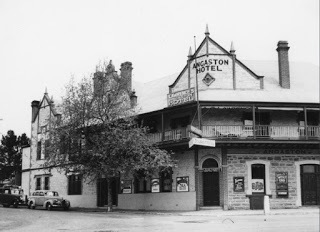 Angaston Hotel 1940 SLSA PRG 1356/4/52 George Simpson was the first licensee of the Angaston Hotel in 1846. Simpson advertised his hotel in The South Australian (newspaper) on Christmas Day 1846 as:
Angaston Hotel 1940 SLSA PRG 1356/4/52 George Simpson was the first licensee of the Angaston Hotel in 1846. Simpson advertised his hotel in The South Australian (newspaper) on Christmas Day 1846 as:
“ANGASTON – ANGAS PARK.
GEORGE SIMPSON respectfully informs the public and inhabitants of the above town, and gentlemen visiting the Poonawurta and Angas Mines (which are in the immediate neighbourhood) and the River Murray, that he has opened a house of accommodation, called the “Angaston Hotel” where he intends to keep a constant supply of the best wines, spirits, and other liquor, and solicits that support which it will be his study to merit.”[2]
In 1847, the Angaston Hotels publican changed from Simpson to William Hughes. Nicholas Player returned as the publican during 1859 and early 1860, before leasing the hotel to George Fuller until 1861, then James Nolan from 1862 until 1863. From 1863 until 1865 the hotel publican was Richard Milson, followed by AR Preston in 1870, and CF Beaumont from 1870-71.
In 1871 the Angaston Inn changed ownership when Mr Beaumont sold the hotel to Mr Buckerfield of Kapunda. The hotel then went through various publicans including James Klotz 1879-1884, George Lawrence 1884-1886 and Arthur Worby 1886-87.
The hotel was then bought by Frederick Leach in 1887, as owner publican he ran the hotel until 1901. He then leased the hotel to Albrecht Borchers until 1904, followed by Thomas Davies from 1904-07 and Edward Cummins from 1907 until 1910.
In 1910, Leach sold the hotel to William Mitchell who leased the hotel to its first female publican, Janet Bleechmore. Mitchell is credited for building the upper level of the hotel in 1914, which is also the same year the hotel licensee, Albert Lambert was taken to insolvency court by creditors. Mitchell later sold the hotel to William Birdseye who owned it from 1917 until 1951. In 1950, Birdseye, now 80 years old, planned to buy more land behind the hotel to extend the accommodation wing.
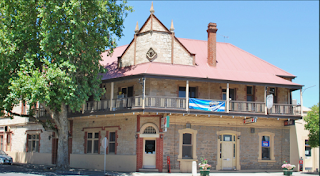 This area was originally occupied by the indigenous Peramangk peoples. In December 1838, Colonel Light and his party are recorded as the first Europeans entering the area. In 1939, South Australian Company Geologist, Johannes Menge wrote to George Fife Angas in England of the suitability of the area for vineyards. Angaston was originally known as Angas Town in the region of German Pass, often people cite German Pass as being the original name, but there is evidence in newspapers from 1843 that this was not the case.
This area was originally occupied by the indigenous Peramangk peoples. In December 1838, Colonel Light and his party are recorded as the first Europeans entering the area. In 1939, South Australian Company Geologist, Johannes Menge wrote to George Fife Angas in England of the suitability of the area for vineyards. Angaston was originally known as Angas Town in the region of German Pass, often people cite German Pass as being the original name, but there is evidence in newspapers from 1843 that this was not the case.
The rear yard of the Angaston Hotel also contains walls that were once part of the Angaston townships original council pound for stray animals.
The Angaston Hotel is allegedly haunted by a spirit that likes to torment kitchen staff. It has been known to upend tables, push objects off benches, slam cupboard and kitchen doors, and rattle metallic objects!
It is not known who the mischievous spirit might be. The hotel was often used for inquests on dead bodies, but there are few records of deaths or suicides in the building.
Research and written by Allen Tiller © 2019
Sources:
'Advertising', South Australian, (25 December 1846), p. 3.
'ANGASTONS COMMUNITY HOTEL MOVE FAILS TO REACH FIGURE', Leader, (4 October 1951) p. 1.
'ANNUAL MEETING OF MAGISTRATES. Monday, March 13.', South Australian, (14 March 1848), p. 2.
'COUNTRY NEWS.', The Express and Telegraph, (17 February 1871), p. 2.[11]
'COURT CASES.', The Advertiser, (2 September 1914), p. 14.
'MITCHELL’S ANGASTON HOTEL.', Saturday Mail, (10 June 1916), p. 2
'NEW GENERAL LICENSES.', South Australian, (15 December 1846), p. 6.
'QUARTERLY MEETING OF MAGISTRATES.', South Australian, (14 September 1847), p. 3.
'THE AMATEUR CONCERT.', South Australian Register, (8 November 1843), p. 2.
'Truro Farewell to Mr and Mrs F. Nicholls', Leader, (9 October 1952), p. 1.
[1] 'NEW GENERAL LICENSES.', South Australian, (15 December 1846), p. 6.
[2] 'Advertising', South Australian, (25 December 1846), p. 3.
[3] 'QUARTERLY MEETING OF MAGISTRATES.', South Australian, (14 September 1847), p. 3.
[4] 'ANNUAL MEETING OF MAGISTRATES. Monday, March 13.', South Australian, (14 March 1848), p. 2.
[5] 'ANGASTON.', South Australian Register, (14 March 1856), p. 3.
[6] 'COURT CASES.', The Advertiser, (2 September 1914), p. 14.
[7] 'PERSONAL', Leader, (6 April 1950), p. 3.
[8] 'ANGASTON COMMUNITY HOTEL MOVE FAILS TO REACH FIGURE', Leader, (4 October 1951) p. 1.
[9] 'Truro Farewell to Mr and Mrs F. Nicholls', Leader, (9 October 1952), p. 1.
[10] 'THE AMATEUR CONCERT.', South Australian Register, (8 November 1843), p. 2.
[11] 'COUNTRY NEWS.', The Express and Telegraph, (17 February 1871), p. 2.
 Angaston Hotel 1940 SLSA PRG 1356/4/52 George Simpson was the first licensee of the Angaston Hotel in 1846. Simpson advertised his hotel in The South Australian (newspaper) on Christmas Day 1846 as:
Angaston Hotel 1940 SLSA PRG 1356/4/52 George Simpson was the first licensee of the Angaston Hotel in 1846. Simpson advertised his hotel in The South Australian (newspaper) on Christmas Day 1846 as:“ANGASTON – ANGAS PARK.
GEORGE SIMPSON respectfully informs the public and inhabitants of the above town, and gentlemen visiting the Poonawurta and Angas Mines (which are in the immediate neighbourhood) and the River Murray, that he has opened a house of accommodation, called the “Angaston Hotel” where he intends to keep a constant supply of the best wines, spirits, and other liquor, and solicits that support which it will be his study to merit.”[2]
In 1847, the Angaston Hotels publican changed from Simpson to William Hughes. Nicholas Player returned as the publican during 1859 and early 1860, before leasing the hotel to George Fuller until 1861, then James Nolan from 1862 until 1863. From 1863 until 1865 the hotel publican was Richard Milson, followed by AR Preston in 1870, and CF Beaumont from 1870-71.
In 1871 the Angaston Inn changed ownership when Mr Beaumont sold the hotel to Mr Buckerfield of Kapunda. The hotel then went through various publicans including James Klotz 1879-1884, George Lawrence 1884-1886 and Arthur Worby 1886-87.
The hotel was then bought by Frederick Leach in 1887, as owner publican he ran the hotel until 1901. He then leased the hotel to Albrecht Borchers until 1904, followed by Thomas Davies from 1904-07 and Edward Cummins from 1907 until 1910.
In 1910, Leach sold the hotel to William Mitchell who leased the hotel to its first female publican, Janet Bleechmore. Mitchell is credited for building the upper level of the hotel in 1914, which is also the same year the hotel licensee, Albert Lambert was taken to insolvency court by creditors. Mitchell later sold the hotel to William Birdseye who owned it from 1917 until 1951. In 1950, Birdseye, now 80 years old, planned to buy more land behind the hotel to extend the accommodation wing.
 This area was originally occupied by the indigenous Peramangk peoples. In December 1838, Colonel Light and his party are recorded as the first Europeans entering the area. In 1939, South Australian Company Geologist, Johannes Menge wrote to George Fife Angas in England of the suitability of the area for vineyards. Angaston was originally known as Angas Town in the region of German Pass, often people cite German Pass as being the original name, but there is evidence in newspapers from 1843 that this was not the case.
This area was originally occupied by the indigenous Peramangk peoples. In December 1838, Colonel Light and his party are recorded as the first Europeans entering the area. In 1939, South Australian Company Geologist, Johannes Menge wrote to George Fife Angas in England of the suitability of the area for vineyards. Angaston was originally known as Angas Town in the region of German Pass, often people cite German Pass as being the original name, but there is evidence in newspapers from 1843 that this was not the case.The rear yard of the Angaston Hotel also contains walls that were once part of the Angaston townships original council pound for stray animals.
The Angaston Hotel is allegedly haunted by a spirit that likes to torment kitchen staff. It has been known to upend tables, push objects off benches, slam cupboard and kitchen doors, and rattle metallic objects!
It is not known who the mischievous spirit might be. The hotel was often used for inquests on dead bodies, but there are few records of deaths or suicides in the building.
Research and written by Allen Tiller © 2019
Sources:
'Advertising', South Australian, (25 December 1846), p. 3.
'ANGASTONS COMMUNITY HOTEL MOVE FAILS TO REACH FIGURE', Leader, (4 October 1951) p. 1.
'ANNUAL MEETING OF MAGISTRATES. Monday, March 13.', South Australian, (14 March 1848), p. 2.
'COUNTRY NEWS.', The Express and Telegraph, (17 February 1871), p. 2.[11]
'COURT CASES.', The Advertiser, (2 September 1914), p. 14.
'MITCHELL’S ANGASTON HOTEL.', Saturday Mail, (10 June 1916), p. 2
'NEW GENERAL LICENSES.', South Australian, (15 December 1846), p. 6.
'QUARTERLY MEETING OF MAGISTRATES.', South Australian, (14 September 1847), p. 3.
'THE AMATEUR CONCERT.', South Australian Register, (8 November 1843), p. 2.
'Truro Farewell to Mr and Mrs F. Nicholls', Leader, (9 October 1952), p. 1.
[1] 'NEW GENERAL LICENSES.', South Australian, (15 December 1846), p. 6.
[2] 'Advertising', South Australian, (25 December 1846), p. 3.
[3] 'QUARTERLY MEETING OF MAGISTRATES.', South Australian, (14 September 1847), p. 3.
[4] 'ANNUAL MEETING OF MAGISTRATES. Monday, March 13.', South Australian, (14 March 1848), p. 2.
[5] 'ANGASTON.', South Australian Register, (14 March 1856), p. 3.
[6] 'COURT CASES.', The Advertiser, (2 September 1914), p. 14.
[7] 'PERSONAL', Leader, (6 April 1950), p. 3.
[8] 'ANGASTON COMMUNITY HOTEL MOVE FAILS TO REACH FIGURE', Leader, (4 October 1951) p. 1.
[9] 'Truro Farewell to Mr and Mrs F. Nicholls', Leader, (9 October 1952), p. 1.
[10] 'THE AMATEUR CONCERT.', South Australian Register, (8 November 1843), p. 2.
[11] 'COUNTRY NEWS.', The Express and Telegraph, (17 February 1871), p. 2.
Published on July 16, 2019 02:30
July 8, 2019
Closed Hotels of South Australia: The College Arms Hotel. (Cnr. Currie & Rosina Streets.)
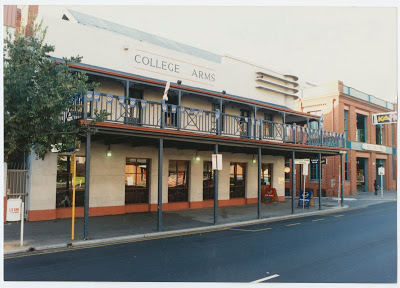 Closed Hotels of South Australia: The College Arms Hotel. (Cnr. Currie & Rosina Streets.)
Closed Hotels of South Australia: The College Arms Hotel. (Cnr. Currie & Rosina Streets.)Situated on the corner of Currie Street and Rosina Street, the Coronation Hotel was established in 1846 as the Golden Fleece Inn. From 1871 until 1937, the hotel was known as The Crown Inn, from 1937 until 1979 it was known as The Coronation Hotel. From 1979 until 1984 it was known as Hotel California, and from 1984 until 1987 it was known as Armstrong’s Tavern. Its last incarnation was as The College Arms Hotel when it was run in conjunction with the TAFE-SA.
The hotel was opened by Andrew Harriot in 1846, who leased the hotel in 1848 to Donald Stewart. Stewart didn’t see out the year before he sold hotel lease to William Gardener. Gardener on-sold to Francis Bunn in 1850 who kept the hotel until 1854. The next lessee was James Robinson who in 1855 sold the lease back to Andrew Harriot.
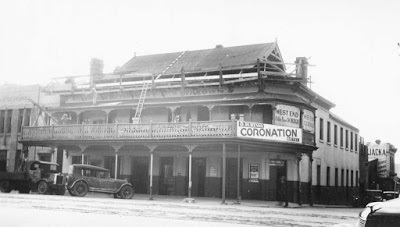
The hotel was sold to Goodman Hart in 1860 who operated it until 1862. The next two lessees were female, Margaret Dymond: 1860-1862, and Mary Ann Richards from 1862 until 1866. Three more Lessee’s took the hotel (Charles Mallen: 1866-1867, Robert Poole: 1867-1868 and Joseph Backhouse: 1868-1869) before Goodman Hart retook his lease from 1869 until 1871.
From 1871 until 1937 the hotel had another 34 publicans – you can find a list of all publicans here: https://localwiki.org/adelaide-hills/Adelaide_Hotels_-_Currie_Street
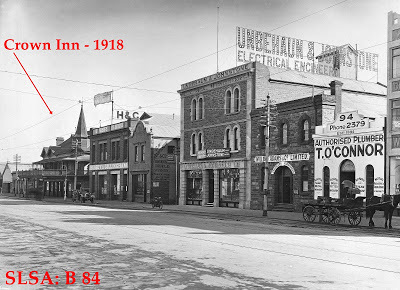 The Crown Inn - 1918. SLSA B84
The Crown Inn - 1918. SLSA B84 The hotel changed its name in 1937 under the ownership of Elise Maude McKeown to The Coronation Hotel. In the next few years, the hotel was constantly in the news for all the wrong reasons. Publicans were caught selling alcohol illegally after hours, and bar staff and patrons were caught betting illegally by the undercover Police Gaming Squad.
The Coronation Hotel was also at the centre of a legal case in 1939 when under the ownership of Daniel Kenny. Kenny had challenged in court the legality of Ballroom dancing to be held in South Australian hotels. The law at the time stated that for dancing to occur in a hotel, the licensee had to have written permission from two Justices of the Peace, one of whom must be the Commissioner, a superintendent, inspector or sub-inspector of the South Australian Police.
Kenny lost the case when Justice Muirhead found it illegal. During an appeal the following year, it was revealed that other hotels in the vicinity were allowed to hold dancing. Lawyer for Kenny, Mr Travers equated the allowing of one hotel, over another to hold dances as an act of: “one law for the rich and another for the poor”.
Due to the stresses of the court case and the constant harassment of police, Kenny sold his lease to Joseph Kilgariff in 1940.
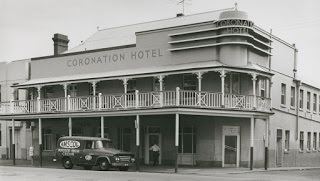 The Coronation Hotel - circa 1966. SLSA: B16356 In 1979, the hotel rebranded as the Hotel California, a discotheque featuring a raised DJ box above the dance floor. From 1984 until 1987 it was known as Armstrong’s Tavern which was considered a safe hotel for the local gay community. From 1987 it was known as The College Arms Hotel and was used to train TAFE students. The hotel was demolished to make way for an update to the Adelaide TAFE-SA campus.
The Coronation Hotel - circa 1966. SLSA: B16356 In 1979, the hotel rebranded as the Hotel California, a discotheque featuring a raised DJ box above the dance floor. From 1984 until 1987 it was known as Armstrong’s Tavern which was considered a safe hotel for the local gay community. From 1987 it was known as The College Arms Hotel and was used to train TAFE students. The hotel was demolished to make way for an update to the Adelaide TAFE-SA campus.Researched and written by Allen Tiller © 2019
Sources:
'ADELAIDE POLICE NOT INTELLIGENCE OFFICER, POLICE SAY', The Advertiser, (21 March 1940), p. 7.
'Obtained Liquor After Hours', The Advertiser, (3 February 1939), p. 30.
'ADELAIDE POLICE', The Advertiser, (16 January 1940), p. 6
‘'Put-and-Take Players Fined 5/’, The News, (30 November 1942), p.5.
'ADELAIDE POLICE', The Advertiser, (2 July 1946), p. 5.
'BARMAN TO PAY £42', News, (7 June 1950), p. 2.
'Four Men Fined For Liquor Offences', News, (2 February 1939), p. 16.
'MAGISTRATE RULES HOTEL DANCING IS ILLEGAL', News, (28 November 1939), p. 7.
'DANCING IN HOTEL', News, (15 January 1940), p. 8.
'ADELAIDE POLICE', The Advertiser, (16 January 1940), p. 6.
Published on July 08, 2019 17:30
July 1, 2019
The Death of Samuel Robinson.
The Death of Samuel Robinson.
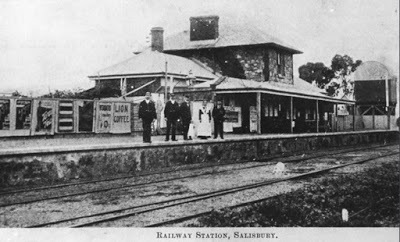 Salisbury Railway Station circa 1890 For many years, Samuel Robinson and his wife, Emily (nee Challender) lived with their children on a property “about half a mile from the railway station on the banks of the River Para.”
Salisbury Railway Station circa 1890 For many years, Samuel Robinson and his wife, Emily (nee Challender) lived with their children on a property “about half a mile from the railway station on the banks of the River Para.”Samuel worked as a Bailiff in the local Salisbury courthouse The day before Samuel was due to collect his money, he was seen tending to his garden, happily waving to passers-by. That evening, another old man was seen to be visiting the couple in their home.
The next morning, the visiting man was seen waving off Emily Robinson at the train station. Samuel was not seen present to see her off, which made some locals suspicious.
Emily travelled to Adelaide and visited Mr. Varco, Samuel's attorney, and signed for his money. She informed Varco, that Samuel was dead. She then went to the funeral home and arranged his funeral and the removal of his body. She also visited a doctor to try and persuade him to give her a death certificate without the doctor seeing the body. He refused, so Emily visited a local JP to get burial approval.
The Salisbury police were phoned about the situation. They went to Pemberton Cottage, spoke to Mrs Robinson, then removed Samuel's body to be taken to the funeral parlour.
Six weeks later, Emily Robinson married her mysterious caller who had seen her off at the train station on the morning Samuel died. His name was Mr Thomas Smith, a neighbour to the Robinson's.The marriage caused outrage in Salisbury. 30 people signed a petition to get the police to hold an inquiry into Samuel's death, but the police and local magistrates refused to investigate. An unruly mob of angry locals formed in the town and descended upon Pemberton Cottage and the newly married Smiths, both in their 80s. They smashed the front door off its hinges, they cut holes through the roof and pelted stones through. The mob pelted the front of the house with rotten eggs and the whole neighbourhood descended into pandemonium, with neighbours hollering and hooting and banging on kerosene drums.
The local police trooper wasn’t present in the town, so the duties of law and order fell onto one brave local J.P. who tried in vain to settle the unruly mob. When the local trooper returned at 11pm that night the mob dispersed.
Every evening, people would walk past the house and scream “murderer” in its general direction. One night, the screams of “murder” came from inside the house. Three men burst through a locked door and threw a meat cleaver at Emily Smith (the former Mrs Robinson), badly cutting her toes. They also beat her savagely with a crowbar. Mrs Smith put in a complaint to the police, but the men were never caught.
The following day Mrs Smith released a statement, in which said that Samuel had died from convulsions at the age of 86. He died in the same way as his father and numerous brothers and had prepared for his own death. He had left instructions for her to attend the office Mr Varco in Adelaide, his attorney who would have further instruction for her. She stated that Mr Robinson knew of her relationship with Mr Smith, and had given them his blessing that should he die, they should marry to take care of each other.A police order was issued in Salisbury, that all abuse toward the Smiths should stop immediately or the full extent of the law would be felt to those who disobeyed. The Attorney Generals Office also spoke on the matter, stating that no inquiry into Mr Robinsons Death would be needed. Statements had been collected on the day of his death, and a full medical examination by Dr Nesbitt, showing he had died in the morning, not the evening prior, had been submitted at the time. The Police and the Attorney Generals Office did not see anything suspicious in Emily Robinson or Thomas Smiths behaviour and the case was never investigated.
As an interesting postscript, Mr Varco advertised in local newspapers the sale of Samuel Robinson's goods only a week after his death. One must wonder if Mr and Mrs Smith received the profits from that sale as well!
Researched and written by Allen Tiller © 2019
1891 'STRANGE CIRCUMSTANCES AT SALISBURY.', Adelaide Observer (SA: 1843 - 1904), 5 December, p. 33. , viewed 15 Apr 2019, http://nla.gov.au/nla.news-article160189151
1891 'Scandal at Salisbury.', Evening Journal (Adelaide, SA: 1869 - 1912), 1 December, p. 2. (SECOND EDITION), viewed 15 Apr 2019, http://nla.gov.au/nla.news-article198424727
1891 'Family Notices', South Australian Register (Adelaide, SA: 1839 - 1900), 1 October, p. 4. , viewed 15 Apr 2019, http://nla.gov.au/nla.news-article48251974
1881 'CATHOLIC PICNIC AT SALISBURY.', South Australian Weekly Chronicle (Adelaide, SA: 1881 - 1889), 31 December, p. 11. , viewed 15 Apr 2019, http://nla.gov.au/nla.news-article91288822
1857 'APPOINTMENTS.', Adelaide Observer (SA : 1843 - 1904), 19 December, p. 5. , viewed 15 Apr 2019, http://nla.gov.au/nla.news-article158115670
1891 'THE MAIN ROADS BILL.', South Australian Register (Adelaide, SA: 1839 - 1900), 2 December, p. 5. , viewed 15 Apr 2019, http://nla.gov.au/nla.news-article48251012
1891 'Advertising', Bunyip (Gawler, SA: 1863 - 1954), 6 November, p. 3. , viewed 15 Apr 2019, http://nla.gov.au/nla.news-article972...
Published on July 01, 2019 15:32



